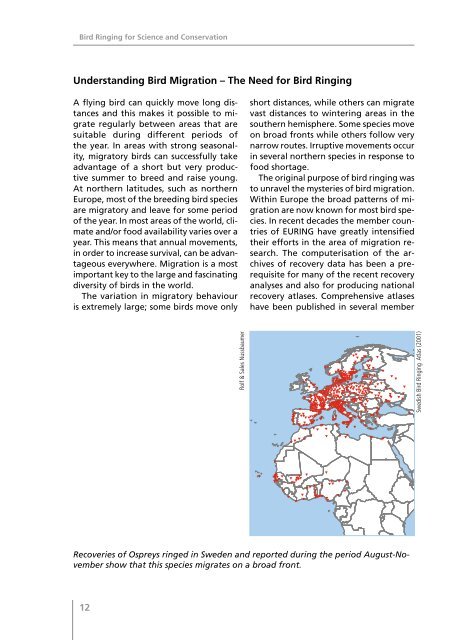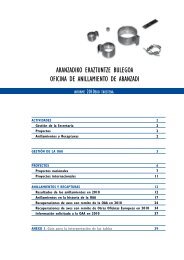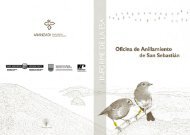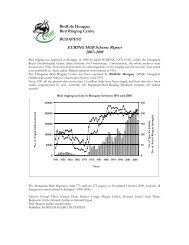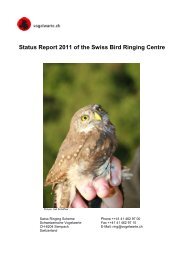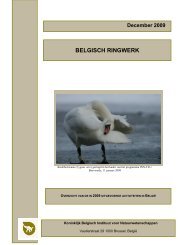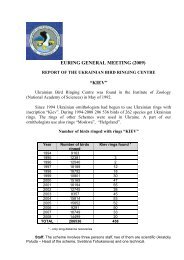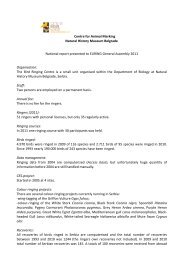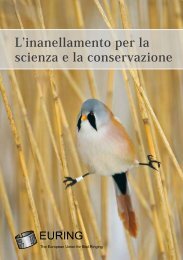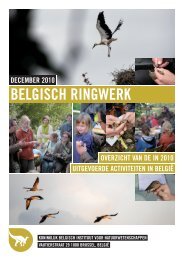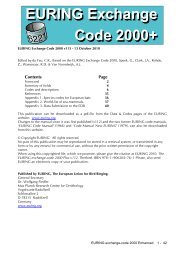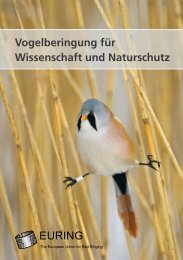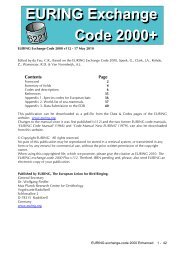Bird Ringing for Science and Conservation - The European Union ...
Bird Ringing for Science and Conservation - The European Union ...
Bird Ringing for Science and Conservation - The European Union ...
- No tags were found...
You also want an ePaper? Increase the reach of your titles
YUMPU automatically turns print PDFs into web optimized ePapers that Google loves.
<strong>Bird</strong> <strong>Ringing</strong> <strong>for</strong> <strong>Science</strong> <strong>and</strong> <strong>Conservation</strong><br />
<strong>Bird</strong> <strong>Ringing</strong> <strong>for</strong> <strong>Science</strong> <strong>and</strong> <strong>Conservation</strong><br />
Underst<strong>and</strong>ing <strong>Bird</strong> Migration – <strong>The</strong> Need <strong>for</strong> <strong>Bird</strong> <strong>Ringing</strong><br />
A flying bird can quickly move long distances<br />
<strong>and</strong> this makes it possible to migrate<br />
regularly between areas that are<br />
suitable during different periods of<br />
the year. In areas with strong seasonality,<br />
migratory birds can successfully take<br />
advantage of a short but very productive<br />
summer to breed <strong>and</strong> raise young.<br />
At northern latitudes, such as northern<br />
Europe, most of the breeding bird species<br />
are migratory <strong>and</strong> leave <strong>for</strong> some period<br />
of the year. In most areas of the world, climate<br />
<strong>and</strong>/or food availability varies over a<br />
year. This means that annual movements,<br />
in order to increase survival, can be advantageous<br />
everywhere. Migration is a most<br />
important key to the large <strong>and</strong> fascinatin g<br />
diversity of birds in the world.<br />
<strong>The</strong> variation in migratory behaviour<br />
is extremely large; some birds move only<br />
Rolf & Sales Nussbaumer<br />
short distances, while others can migrate<br />
vast distances to wintering areas in the<br />
southern hemisphere. Some species move<br />
on broad fronts while others follow very<br />
narrow routes. Irruptive movements occur<br />
in several northern species in response to<br />
food shortage.<br />
<strong>The</strong> original purpose of bird ringing was<br />
to unravel the mysteries of bird migration.<br />
Within Europe the broad patterns of migration<br />
are now known <strong>for</strong> most bird species.<br />
In recent decades the member countries<br />
of EURING have greatly intensified<br />
their ef<strong>for</strong>ts in the area of migration research.<br />
<strong>The</strong> computerisation of the archives<br />
of recovery data has been a prerequisite<br />
<strong>for</strong> many of the recent recovery<br />
analyses <strong>and</strong> also <strong>for</strong> producing national<br />
recovery atlases. Comprehensive atlases<br />
have been published in several member<br />
Recoveries of Ospreys ringed in Sweden <strong>and</strong> reported during the period August-November<br />
show that this species migrates on a broad front.<br />
Swedish <strong>Bird</strong> <strong>Ringing</strong> Atlas (2001)<br />
Parallel <strong>and</strong> narrow migration routes<br />
shown by different populations of<br />
Chaffinches ringed during passage at<br />
two bird observatories in Europe. Black<br />
dots refer to recovery places of birds<br />
ringed at Courish Spit, Russia (filled<br />
square) <strong>and</strong> open dots refer to birds<br />
ringed at Col de Bretolet, Switzerl<strong>and</strong><br />
(open square).<br />
countries <strong>and</strong> work has begun on them<br />
in a number of others. This is an important<br />
step because it will make results from<br />
ringing easily accessible. It will also show<br />
where knowledge is missing <strong>and</strong> where ef<strong>for</strong>ts<br />
in the future ringing should be focused.<br />
As migration pattern change over<br />
time, particularly in relation to factors<br />
such as climate change, continued bird<br />
ringing is important even <strong>for</strong> common<br />
species.<br />
Migration is a challenge within nature<br />
conservation work since many populations<br />
of birds regularly move over huge areas,<br />
<strong>and</strong> problems en route or in the winter-<br />
<br />
ing quarters can result in declining breeding<br />
populations in areas far away. Many<br />
migratory birds are declining in numbers<br />
<strong>and</strong> detailed in<strong>for</strong>mation about the annual<br />
movements, including important<br />
stop-over sites <strong>and</strong> winter quarters, is a<br />
top conservation priority.<br />
Large numbers of ringing recoveries are<br />
now held in the EURING Data Bank <strong>and</strong><br />
they can be used to analyse more complex<br />
questions about bird migration. Results of<br />
such analyses could <strong>for</strong>m the basis of detailed<br />
laboratory <strong>and</strong> field research into<br />
the navigational cues <strong>and</strong> fuelling strategies<br />
that birds use when migrating.<br />
Sergio Tirro<br />
after Zink <strong>and</strong> Bairlein 1995<br />
12<br />
13


